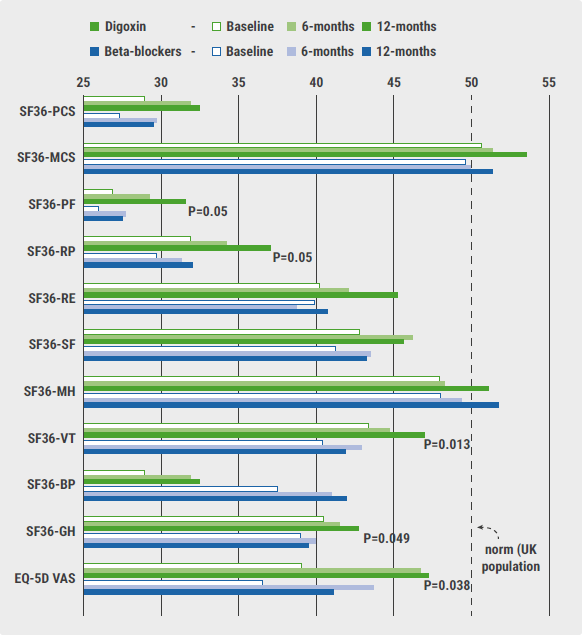Beta-blockers are commonly used for rate control due to their beneficial effects in heart failure with reduced ejection fraction. However, the observed mortality benefit does not appear to extend to those with AF in double-blind, randomised trials. Data on digoxin suffers from prescription bias, as doctors typically preserve digoxin for sicker, older patients with more comorbidities. Although digoxin has been in use since 1785, no longer-term trials with digoxin in patients with AF or AF with heart failure have been performed.
This was the motivation for the randomised, phase 4 RATE-AF trial to evaluate beta-blockers and digoxin for long-term heart rate control in patients with permanent AF and symptoms of heart failure. The trial, presented by Prof. Dipak Kotecha (University of Birmingham, UK), included 160 patients in need of rate control for AF, aged ≥60 years (mean age 76 years), and with permanent AF and breathlessness (NYHA class II or above). Most AF symptoms at baseline were moderate or severe: modified EHRA 2b was present in 47% of patients and mEHRA 3 in 40%. Over half (52%) had signs of heart failure at baseline (median NTproBNP 1,057 pg/mL; 19% had a LVEF <50%).
The results showed that heart rate reduced at a similar extent in patients who received a beta-blocker or digoxin. The primary outcome, SF36 quality of life using the Physical Component Summary score at 6 months, increased in both groups with no significant difference (adjusted mean difference 1.33; 95% CI -1.22-3.89; P=0.30; see Figure). Notably, the participants showed a substantial lower quality of life across all domains compared with the norm for these patients. Over time, quality of life across these domains continued to improve with digoxin.
Figure: Patient-reported quality of life in the RATE-AF trial [1]

- Kotecha D. RAte control Therapy Evaluation in permanent Atrial Fibrillation. Atrial Fibrillation session, ESC Congress 2020, 29 Aug.
Posted on
Previous Article
« SGLT2 inhibitor ertugliflozin shows similar mortality but fewer HF hospitalisations Next Article
Reduced progression of coronary atherosclerosis with icosapent ethyl »
« SGLT2 inhibitor ertugliflozin shows similar mortality but fewer HF hospitalisations Next Article
Reduced progression of coronary atherosclerosis with icosapent ethyl »
Table of Contents: ESC 2020
Featured articles
2020 ESC Clinical Practice Guidelines
2020 Atrial Fibrillation Guidelines
2020 Non-ST-Segment Elevation Acute Coronary Syndromes Guidelines
2020 Sports Cardiology and Exercise in Cardiovascular Patients Guidelines
2020 Adult Congenital Heart Disease Guidelines
Hot Line Presentations
SGLT2 inhibitor improves cardiovascular outcomes in heart failure patients
First-in-class cardiac myosin inhibitor effective in obstructive hypertrophic cardiomyopathy
Reduced cardiovascular outcomes with early rhythm control
Trimetazidine after successful PCI not associated with fewer cardiac events
POPular TAVI: Aspirin-only antiplatelet strategy?
Reduced NT-proBNP in HFpEF with sacubitril/valsartan
DAPA-CKD: Dapagliflozin improves CKD survival ± diabetes
Low-dose colchicine reduces CV death and ischaemic events in coronary disease
Similar outcomes sPESI and HESTIA for pulmonary embolism triage
Antihypertensives also reduce CV risk in people with normal blood pressure
COVID-19: Continuing versus suspending ACE inhibitors and ARBs
Drug initiation strategy not associated with increased use of oral anticoagulants
Restrictive blood transfusion non-inferior and cost-effective strategy
Late-Breaking Science
Increased mortality with colchicine in patients with ACS
Rivaroxaban protects limbs and ischaemic events in CAD-PAD patients
Antisense APOC3 oligonucleotide lowers triglyceride and atherogenic lipoproteins
Antisense ANGPTL3 lowers triglycerides
Reduced progression of coronary atherosclerosis with icosapent ethyl
Digoxin improves symptoms in stable patients with permanent AF
SGLT2 inhibitor ertugliflozin shows similar mortality but fewer HF hospitalisations
COVID and Cardiovascular Disease
Risk factors for thromboembolism and bleeding in COVID-19: lessons from Wuhan
The Yale COVID-19 Cardiovascular Registry
COVID-19 treatments and the importance of randomised trials
Related Articles
November 5, 2020
2020 Non-ST-Segment Elevation Acute Coronary Syndromes Guidelines
November 5, 2020
Rivaroxaban protects limbs and ischaemic events in CAD-PAD patients
November 5, 2020
POPular TAVI: Aspirin-only antiplatelet strategy?
© 2024 Medicom Medical Publishers. All rights reserved. Terms and Conditions | Privacy Policy
HEAD OFFICE
Laarderhoogtweg 25
1101 EB Amsterdam
The Netherlands
T: +31 85 4012 560
E: publishers@medicom-publishers.com

